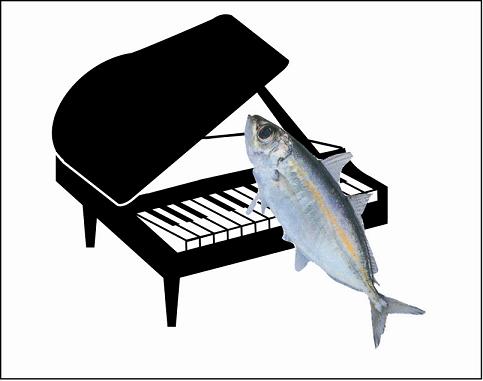What’S the Difference between a Piano And a Fish

A piano is a musical instrument, while a fish is a living aquatic animal. Pianos are commonly used to create melodies, harmonies, and rhythms in music, and are made up of keys, strings, and a wooden frame.
Fish, on the other hand, are cold-blooded creatures that inhabit water bodies and respire through gills. In terms of purpose, pianos are crafted for artistic expression and entertainment, while fish play a vital role in aquatic ecosystems, contributing to biodiversity and the balance of underwater ecosystems.
These two entities differ significantly in their nature, function, and composition, making the comparison between a piano and a fish an intriguing contrast. Further exploration into their unique characteristics will help shed light on their distinctive qualities and how they contribute to various aspects of human life and the natural world.

Credit: twitter.com
The Musical Marvel: A Brief Introduction To Pianos
Pianos and fish may seem like an odd comparison, but their differences are apparent. Pianos are musical instruments that produce sounds when keys are pressed, while fish are aquatic creatures that swim and breathe underwater. Pianos have a rich history, dating back to the early 18th century, with inventors like bartolomeo cristofori revolutionizing the instrument.
Over the years, pianos have evolved, resulting in various types such as grand, upright, and digital pianos. Each type offers a unique sound and playing experience. Today, pianos are cherished for their ability to create beautiful melodies and harmonies, while fish enrich aquatic ecosystems with their diverse species and behaviors.
While their purposes vastly differ, both pianos and fish captivate people in their own distinct ways. So, let’s explore the fascinating world of pianos and appreciate the marvels of music they bring to our lives.
Unveiling The Inner Workings Of A Piano
Pianos and fish may seem worlds apart, but beneath their surface, there are curious similarities. To truly understand a piano, we must delve into its inner workings, examining its key components: the keys themselves, the strings that produce sound, and the soundboard that amplifies it.
These intricate mechanics work together harmoniously to create the beautiful melodies we enjoy. Yet, sound production in pianos goes beyond physicality; tuning and maintenance play a crucial role. Regular tuning ensures that each note is in perfect harmony, while proper maintenance keeps the piano in optimal condition.
Just as fish need the right environment to thrive, a well-maintained piano fulfills its potential, delivering breathtaking music. So, next time you sit before a piano, take a moment to appreciate the intricate mechanics and the captivating sounds they produce.
Exploring The Musical Versatility Of Pianos
Pianos, unlike fish, are musical instruments known for their versatility and grandeur. They have played a pivotal role in classical music for centuries. From the majestic melodies of mozart to the emotionally charged compositions of beethoven, pianos have been integral to the classical genre.
But their influence doesn’t stop there. Pianos have then transcended into popular and contemporary genres, adding depth and richness to countless songs. Think of elton john’s iconic piano-driven ballads or the haunting melodies of adele. Moreover, pianos have become an essential instrument in jazz and improvisation.
The intricate keys and dynamic range allow musicians to explore their creativity and push the boundaries of their musical expression. So, whether you’re listening to a classical masterpiece, a pop chart-topper, or a soulful jazz tune, the unmistakable sound of a piano will always be there to captivate and inspire.
A Closer Look At The Aquatic Creatures: Fish
Fish are fascinating creatures found in various habitats and adapt to their environment in unique ways. They are a diverse group of vertebrates with different species across the globe. Fish play a crucial role in the ecosystem, serving as indicators of environmental health and contributing to the food chain.
From freshwater to saltwater, fish have adapted to live in oceans, rivers, lakes, and even underground caves. Their ability to breathe underwater through gills and their streamlined bodies allow them to swim effortlessly. Fish come in various sizes, shapes, and colors, each with specific adaptations to their surroundings.
Understanding the importance of fish in the ecosystem helps us appreciate their significance in maintaining the delicate balance of nature. So, next time you see a fish, take a moment to admire the incredible adaptations that make them such unique and essential creatures in our world.
Decoding The Anatomy Of Fish
The difference between a piano and a fish lies in the anatomy of the latter. By decoding the external and internal structures of fish, we gain insight into their unique features. Fish scales, fins, and gills play a vital role in their locomotion and respiration.
While scales protect their bodies, fins aid in navigation and movement through water. Gills, on the other hand, are responsible for extracting oxygen from the water. Another fascinating aspect is the sensory organs possessed by fish, which allow them to perceive their surroundings in distinct ways.
From the lateral line system that can detect vibrations and movements to the taste buds found all over their bodies, fish have developed exceptional adaptations. Understanding these features helps us appreciate the diversity and complexity of these aquatic creatures.
The Functions And Behavior Of Fish
Fish are fascinating creatures with unique functions and behaviors. When it comes to locomotion and swimming techniques, fish utilize their fins and tails to propel themselves through the water. Their feeding habits and dietary preferences highlight their adaptability, as they consume a variety of foods ranging from plants to smaller organisms.
Additionally, fish possess intricate communication and interaction methods within their environment. Through visual signals, body language, and chemical cues, they establish social hierarchies, find mates, and protect their territories. Observing these behaviors sheds light on the complexity of the underwater world.
Understanding the differences between a piano and a fish may seem unrelated, but investigating the functions and behavior of fish reveals the diversity and wonders of the natural world. So let’s dive in and explore the intriguing world of fish together.
Distinguishing The Uncommon: Contrasting Features
The distinction between pianos and fish lies in their materials, purpose, functions, lifespan, and life cycles. Pianos, crafted from wood, metal, and ivory, fulfill a musical purpose, providing a melodic medium for artists and enthusiasts. Fish, composed of scales and fins, serve a vital ecological role, contributing to aquatic ecosystems and sustaining marine life.
While pianos can last for generations with proper care and maintenance, fish possess diverse life spans, varying from species to species. Pianos endure for decades, but fish undergo growth, reproduction, and ultimately, mortality within relatively shorter timeframes. These seemingly disparate entities are intricately linked to different aspects of society.
Pianos ignite musical passions and creativity, while fish support the balance of aquatic environments. Recognizing their dissimilarities and appreciating their distinctive characteristics aids in gaining a comprehensive understanding of their individual significance in our world.
Emotional Connection And Experience With Pianos And Fish
Pianos and fish offer distinct emotional connections and experiences. Playing a piano provides joy and appreciation, allowing individuals to express themselves through music. The therapeutic qualities of listening to piano music bring a sense of calm and relaxation, providing solace during stressful times.
On the other hand, the enchantment of interacting with fish and aquariums creates a sense of wonder and tranquility. Observing the graceful movements and vibrant colors of fish can be mesmerizing, offering a peaceful escape from daily routines. Both pianos and fish provide unique experiences that cater to different aspects of human emotions and well-being, offering a range of sensory delights.
Whether dancing one’s fingers across the piano keys or peacefully observing the underwater world, these experiences bring moments of connection and beauty into our lives.
The Impact Of Pianos And Fish On Human Culture
The impact of pianos and fish on human culture is profound, with both playing significant roles throughout history. Pianos have had a tremendous influence on music, shaping genres and captivating audiences with their melodic compositions. The cultural significance of pianos cannot be overstated, as they have become symbols of elegance and sophistication.
On the other hand, fish have fascinated humans through art and literature, symbolizing life, freedom, and exploration. Artists and writers have depicted fish in various forms, reflecting their beauty and capturing their mystique. Additionally, there has been a growing recognition of the need for conservation efforts to preserve fish species and their habitats.
These endeavors aim to maintain the delicate balance of marine ecosystems and ensure the continued existence of these magnificent creatures. The enduring allure of pianos and fish in human culture showcases our innate fascination with the wonders of music and the natural world.
Frequently Asked Questions For What’S The Difference Between A Piano And A Fish
What Are The Key Differences Between A Piano And A Fish?
A piano is a musical instrument that produces sound through keys and strings, while a fish is a living aquatic creature. The main difference lies in their nature and purpose – one is a means of creative expression, while the other is a living being in its own habitat.
Conclusion
To sum it up, the difference between a piano and a fish may seem obvious at first glance, but upon closer examination, we can uncover fascinating similarities and contrasts. Both entities possess their unique characteristics and serve distinct purposes in our lives.
While the piano enchants us with its harmonic melodies and captivates our senses, the fish navigates the depths of the ocean with its grace and agility. Yet, both inspire us to embark on a creative journey, evoking emotions and speaking to our souls in their own distinctive ways.
From a practical standpoint, pianos are musical instruments that require skill and practice, while fish contribute to the ecological balance of aquatic ecosystems. Understanding and appreciating these disparities can deepen our understanding of the diverse aspects of the world we live in.
So, whether you find yourself drawn to the enchanting keys of a piano or the mesmerizing movements of a fish, embrace the beauty in their individuality and let your appreciation for diversity flourish.
